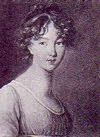
This is the summer of completion – I hope! Another project is off the needles at last, the Gentleman’s Drawers from Weldon’s Practical Knitter, Eleventh Series (c. 1880s.) I worked from Interweave Press’s facsimile edition of Weldon’s Practical Needlework, Volume Four.
The drawers were knit in just under six skeins of Nature Spun Worsted, Silver Sage and one skein of the same in Red Fox on 4.5mm/7 US needles. The legs were knit in the round, and the hips to the waist back and forth on straights.
The original pattern called for “light grey or natural colour wool” and “one skein of scarlet wool,” both in “petticoat weight” knit on “four steel knitting needles No. 12” (modern equivalent 2mm/2.5US.) “Should petticoat wool be considered too heavy 5-ply fingering may be employed.” These drawers are described as “very thick and warm.” Petticoat patterns from earlier in the century, however, usually called for the equivalent of fingering weight wool. Hence my choice of Nature Spun Worsted which is a 3-ply wool, perhaps coming closer to the 5-ply fingering. I would have, however, have had a very difficult time knitting with the 3-ply on 2mm needles and if I had knit in a fingering weight wool on 2mm needles, the drawers would have come out in a size to fit a boy and not a man. Swatching in the beginning was essential when playing the all too frequent guessing game of wool equivalency weights during various eras, even within the same century.
This pair of underdrawers measures 49” from waist down to and including the red border of the ankle cuff, the inside leg is 27 ½” and the ankle cuff, including the red border, 3 ½”. The button band is 11 ½” long. The legs are is 20” at the upper thigh, 15” at knee, and 8” (unstretched) at ribbing of ankle cuff. The hips are 40” as is the waist. The drawers were knit in two separate leg and hip pieces and then sewn together up the back. The roominess in the seat of the drawers was created by half rows every sixth row on each side or leg/hip piece. Stitches for a square gusset were picked up from one of the inside crotch sides and sewn onto the other three sides when completed
The final touches include knitted eyelets in the waistband (for braces/suspenders), red flannel lining at the waist down to the hips, scarlet tape and braid for trimming, and stitching in silk thread around the flannel/knitted buttonholes as well as the decorative stitching in the front from the button panels outwards as seen in the original illustration. I did not do any of the above.




3 comments:
Those drawers are fantastic. Very fine job.
Very impressive! (I keep toying with the idea of making some 1920s or 30s lingerie, and though that's far less guesswork than what you were dealing with, I keep putting it off.)
Thanks! When I look back on the project, the drawers were fun to knit and they do fit real men - two have tried them on already!
I, too, have been tempted by 1930s' lingerie - maybe for next winter?
Post a Comment